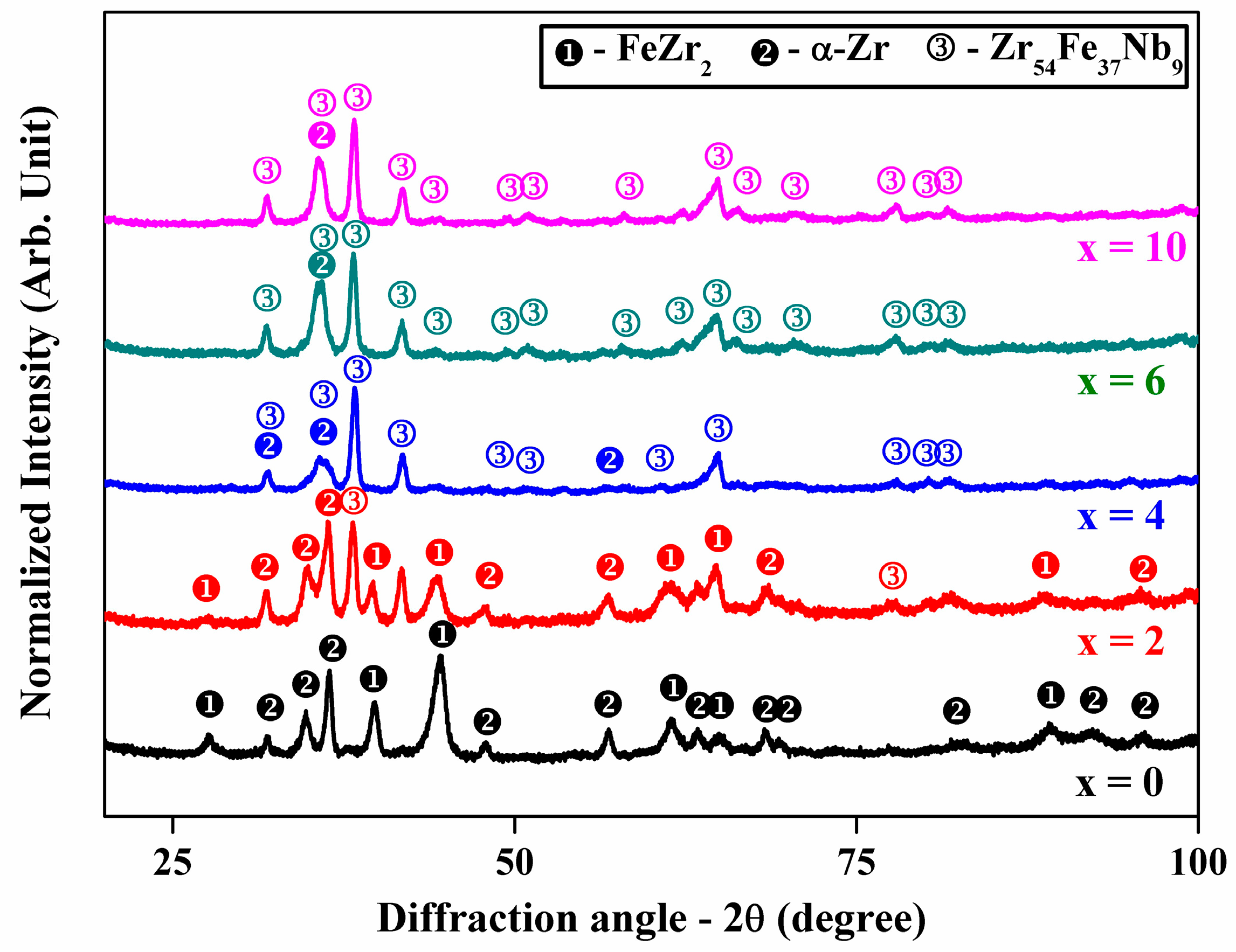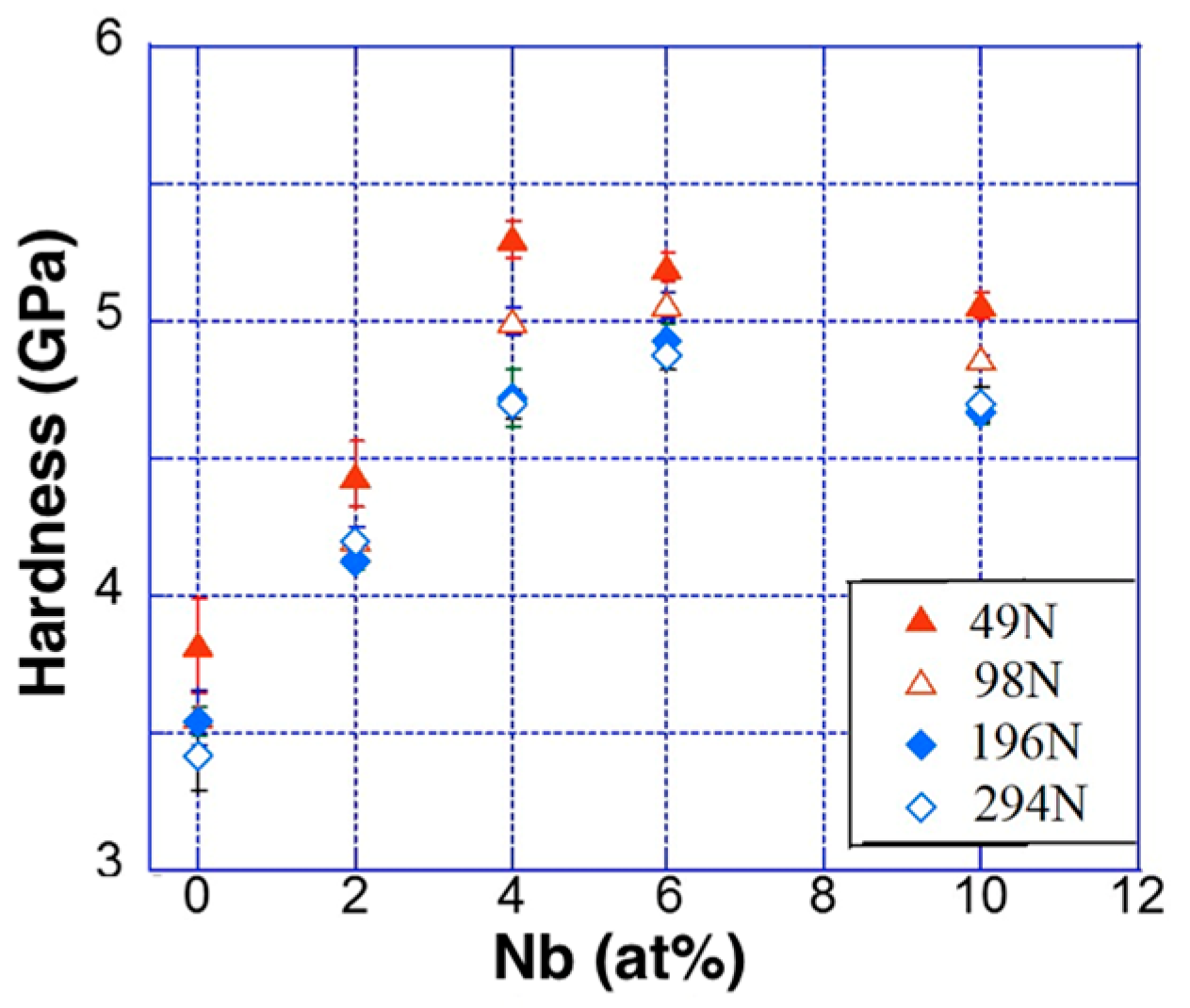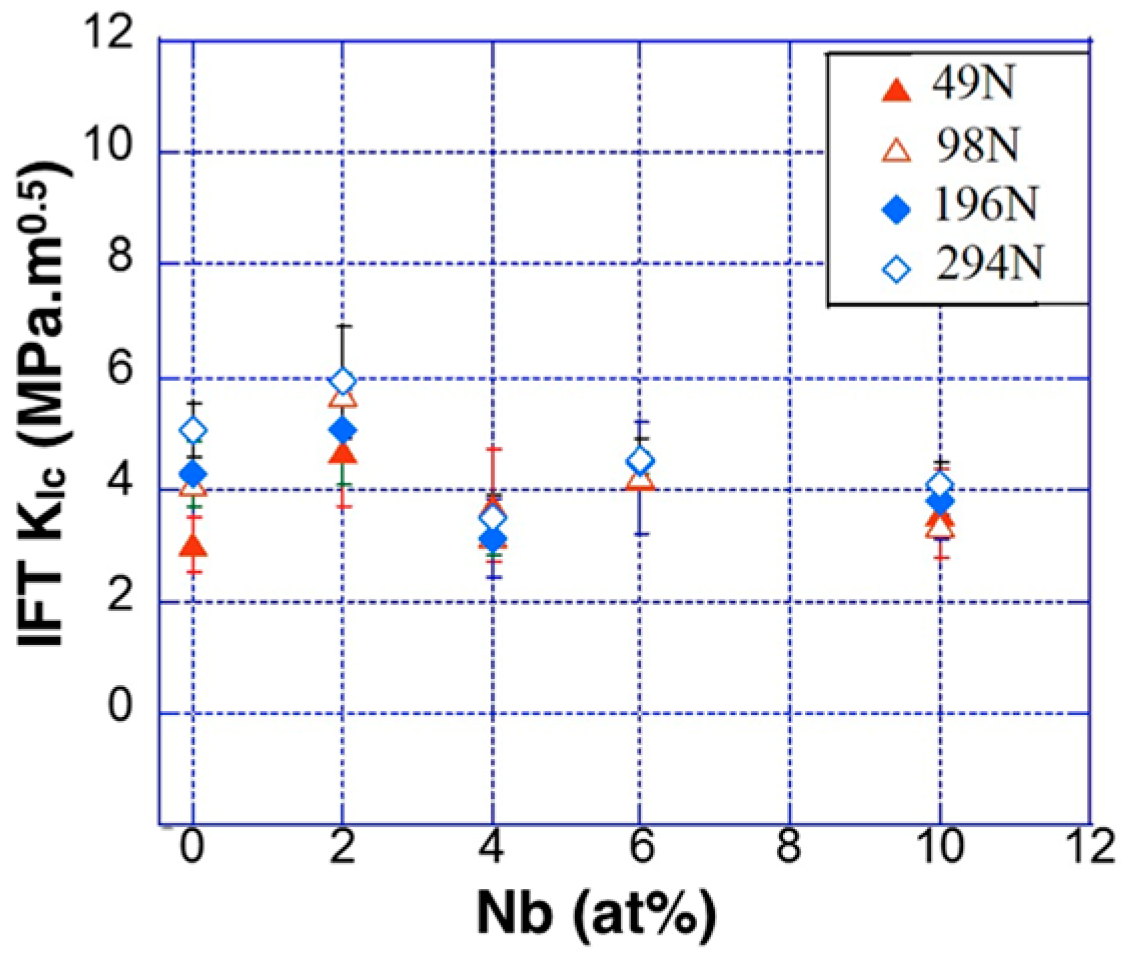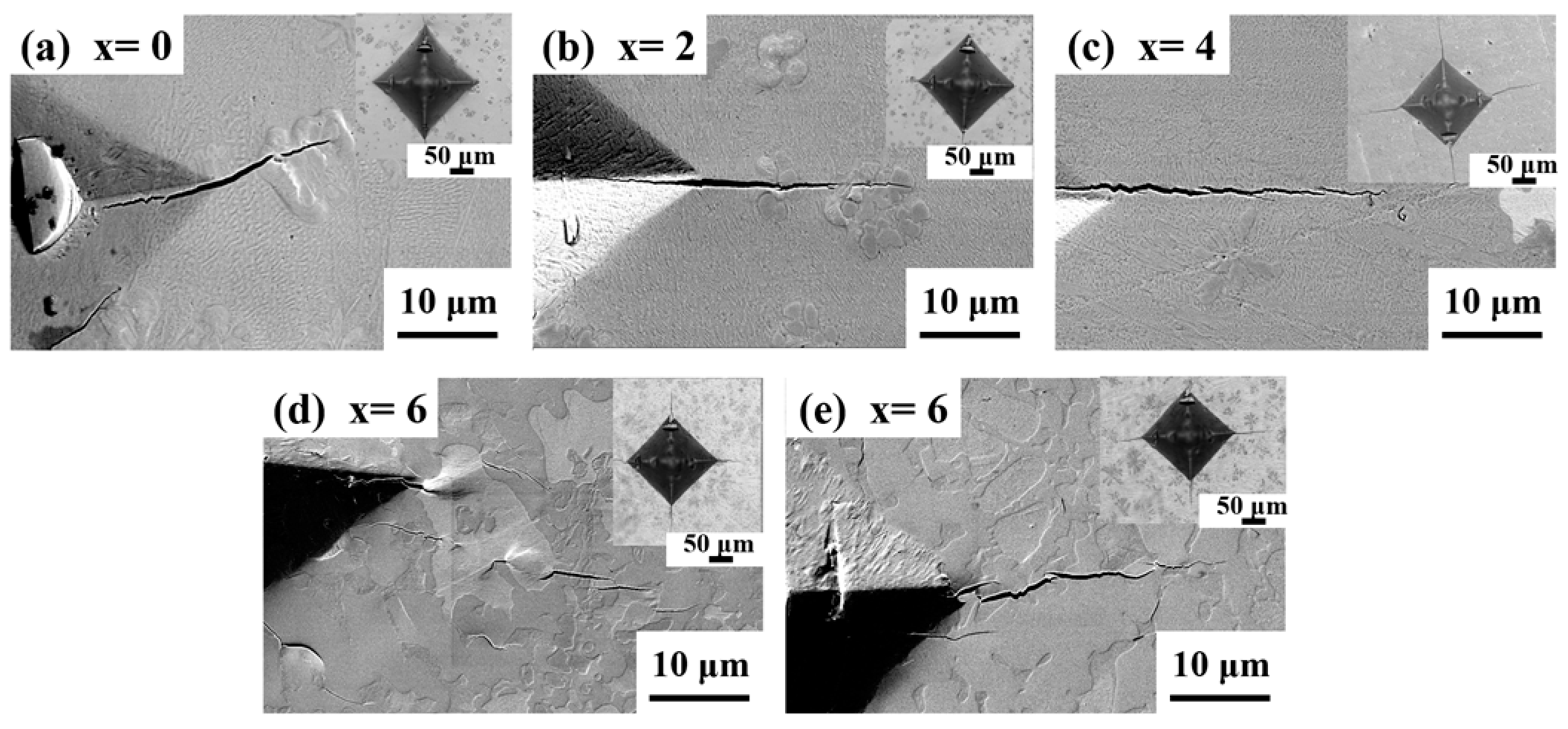Influence of Nb on the Microstructure and Fracture Toughness of (Zr0.76Fe0.24)100−xNbx Nano-Eutectic Composites
Abstract
:1. Introduction
2. Materials and Methods
3. Results and Discussion
3.1. X-ray Diffraction and Phase Analysis of As-Solidified Composites
3.2. Microstructural Characterization of the As-Solidified Composites
3.3. TEM Analysis
3.4. Compressive Deformation Behavior
3.5. Elastic Modulus Measurement
3.6. Vickers Bulk Hardness
3.7. Indentation Fracture Toughness
3.8. Fractrographic Investigation
4. Summary
Acknowledgments
Author Contributions
Conflicts of Interest
References
- Kurz, W.; Fisher, D.J. Dendrite growth in eutectic alloys: The coupled zone. Int. Met. Rev. 1979, 24, 177–204. [Google Scholar] [CrossRef]
- He, G.; Eckert, J.; Loeser, W.; Schultz, L. Novel Ti based nanostructure-dendrite composites with enhanced plasticity. Nat. Mater. 2003, 2, 33–37. [Google Scholar] [CrossRef] [PubMed]
- Eckert, J.; Das, J.; Pauly, S.; Duhamel, C. Mechanical properties of bulk metallic glasses and composites. J. Mater. Res. 2007, 22, 285–301. [Google Scholar] [CrossRef]
- Maity, T.; Das, J. Microstructure and size effect in (Ti70.5Fe29.5)100−xSnx (0 ≤ x ≤ 4) composites. J. Alloys Compd. 2014, 585, 54–62. [Google Scholar] [CrossRef]
- Maity, T.; Roy, B.; Das, J. Mechanism of lamellae deformation and phase rearrangement in ultrafine lamellar β-Ti/FeTi eutectic composites. Acta Mater. 2015, 97, 170–179. [Google Scholar] [CrossRef]
- Maity, T.; Das, J. Origin of plasticity in ultrafine lamellar Ti–Fe–(Sn) composites. AIP Adv. 2012, 2, 032175. [Google Scholar] [CrossRef]
- Das, J.; Kim, K.B.; Baier, F.; Loser, W.; Eckert, J. High-strength Ti-base ultrafine eutectic with enhanced ductility. Appl. Phys. Lett. 2005, 87, 161907. [Google Scholar] [CrossRef]
- Maity, T.; Das, J. High strength Ni–Zr-(Al) nanoeutectic composites with large plasticity. Intermetallics 2015, 63, 51–58. [Google Scholar] [CrossRef]
- Maity, T.; Singh, A.; Dutta, A.; Das, J. Microstructure mechanism on the evolution of plasticity in nanolamellar γ-Ni/Ni5Zr eutectic composites. Mater. Sci. Eng. A 2016, 666, 72–79. [Google Scholar] [CrossRef]
- Park, J.M.; Kim, T.E.; Sohn, S.W.; Kim, D.H.; Kim, K.B.; Kim, W.T.; Eckert, J. High strength Ni–Zr binary ultrafine eutectic-dendrite composite with large plastic deformability. Appl. Phys. Lett. 2008, 93, 031913. [Google Scholar] [CrossRef]
- Lee, S.W.; Kim, J.T.; Hong, S.H.; Park, H.J.; Park, J.Y.; Lee, N.S.; Seo, Y.; Suh, J.Y.; Eckert, J.; Kim, D.H.; et al. Micro-to-nano-scale deformation mechanisms of a bimodal ultrafine eutectic composites. Sci. Rep. 2014, 4, 6500. [Google Scholar] [CrossRef] [PubMed]
- Davies, I.G.; Hellawell, A. The structure of directionally frozen Al-CuAl2 eutectic alloy. Philos. Mag. 1969, 19, 1285–1297. [Google Scholar] [CrossRef]
- Du, D.; Fautrelle, Y.; Ren, Z.; Moreau, R.; Li, X. Effect of a high magnetic field on the growth of ternary Al-Cu-Ag alloys during directional solidification. Acta Mater. 2016, 121, 240–256. [Google Scholar] [CrossRef]
- Park, J.M.; Kim, K.B.; Kim, W.T.; Lee, M.H.; Eckert, J.; Kim, D.H. High strength ultrafine eutectic Fe-Nb-Al composites with enhanced plasticity. Intermetallics 2008, 16, 642–650. [Google Scholar] [CrossRef]
- Park, J.M.; Kim, D.H.; Kim, K.B.; Eckert, J. Improving the plasticity of a high strength Fe-Si-Ti ultrafine composite by introduction of an immiscible element. Appl. Phys. Lett. 2010, 97, 251915. [Google Scholar] [CrossRef]
- Wang, P.; Deng, L.; Prashanth, K.G.; Pauly, S.; Eckert, J.; Scudino, S. Microstructure and mechanical properties of Al-Cu alloys fabricated by selective laser melting of powder mixtures. J. Alloys Compd. 2018, 735, 2263–2266. [Google Scholar] [CrossRef]
- Kim, H.G.; Park, J.Y.; Jeong, Y.H. Ex-reactor corrosion and oxide characteristics of Zr-Nb–Fe alloys with the Nb/Fe ratio. J. Nucl. Mater. 2005, 345, 1–10. [Google Scholar] [CrossRef]
- Markelov, V.A.; Rafikov, V.R.; Nikulin, S.A.; Goncharov, V.I.; Shishov, V.N.; Gusev, A.Y.; Chesnokov, E.K. Changes in the microstructure of the alloy of zirconium with tin, niobium and iron during deformation and heat treatment. Phys. Met. Metallogr. 1994, 77, 380–387. [Google Scholar]
- Sabool, G.P.; Kilp, G.R.; Balfour, M.G.; Roberts, E. Development of a Cladding Alloy for High Burnup. In Proceedings of the 8th International Symposium on Zirconium in the Nuclear Industry, San Diego, CA, USA, 19–23 June 1988. [Google Scholar]
- Ramos, C.; Saragovi, C.; Granovsky, M.S. Some new experimental results on the Zr–Fe–Nb system. J. Nucl. Mater. 2007, 366, 198–205. [Google Scholar] [CrossRef]
- Ramos, C.; Saragovi, C.; Granovsky, M.; Arias, D. Effect of Nb on the Zr2Fe intermetallic stability. J. Nucl. Mater. 2003, 312, 266–269. [Google Scholar] [CrossRef]
- Niihara, K. A Fracture Mechanics Analysis of Indentation-Induced Palmqvist Cracks in Ceramics. J. Mater. Sci. Lett. 1983, 2, 221–223. [Google Scholar] [CrossRef]
- Niihara, K. Indentation Fracture Toughness of Brittle Materials for Palmqvist Cracks. In Fracture Mechanics of Ceramics; Bradt, R.C., Hasselman, D.P.H., Munz, D., Sakai, M., Shevchenko, V.Y., Eds.; Plenum Publishing Co.: New York, NY, USA, 1983; Volume 5, pp. 97–105. [Google Scholar]
- Alekseeva, Z.M.; Korotkova, N.V. Isothermal sections of Zr-Nb–Fe phase diagram within temperature range of 1600 to 850 deg C. Izvestiya Akademii Nauk SSSR Met. 1989, 1, 199–205. [Google Scholar]







| Alloys | Phases | α-Zr | FeZr2 | Zr54Fe37Nb9 | σy (MPa) | σf (MPa) | εf (%) |
|---|---|---|---|---|---|---|---|
| x = 0 | α-Zr + FeZr2 | 69 | 31 | - | 1015 | 1025 | 2.1 |
| x = 2 | α-Zr + Zr54Fe37Nb9 + FeZr2 | 74 | 18 | 8 | 1055 | 1060 | 2.0 |
| x = 4 | α-Zr + Zr54Fe37Nb9 + FeZr2 | 72 | 12 | 16 | 1510 | 1510 | 2.4 |
| x = 6 | Zr54Fe37Nb9 + α-Zr | 72 | - | 28 | 1800 | 1800 | 3.7 |
| x = 10 | Zr54Fe37Nb9 + α-Zr | 61 | - | 39 | 1025 | 1025 | 1.8 |
| Alloys | ρ (g/cc) | ν | E (GPa) | K (GPa) | G (GPa) |
|---|---|---|---|---|---|
| x = 0 | 6.74 | 0.3787 | 68 | 25 | 94 |
| x = 2 | 6.82 | 0.3540 | 87 | 32 | 99 |
| x = 4 | 6.88 | 0.3396 | 97 | 36 | 101 |
| x = 6 | 6.90 | 0.3396 | 101 | 38 | 105 |
| x = 10 | 7.03 | 0.3499 | 96 | 36 | 107 |
| Alloys | Pmax (N) | H (GPa) | l (µm) | KIC (MPa√m) |
|---|---|---|---|---|
| x = 0 | 49 | 3.82 ± 0.17 | 33.09 ± 10 | 3.02 ± 0.5 |
| 98 | 3.56 ± 0.10 | 33.68 ± 5 | 4.08 ± 0.2 | |
| 196 | 3.54 ± 0.05 | 64.22 ± 16 | 4.27 ± 0.6 | |
| 294 | 3.42 ± 0.13 | 67.43 ± 17 | 5.05 ± 0.5 | |
| x = 2 | 49 | 4.44 ± 0.12 | 18.69 ± 9 | 4.67 ± 1.0 |
| 98 | 4.21 ± 0.04 | 21.70 ± 1 | 5.70 ± 0.1 | |
| 196 | 4.13 ± 0.04 | 59.48 ± 19 | 5.07 ± 1.0 | |
| 294 | 4.20 ± 0.02 | 65.26 ± 23 | 5.90 ± 1.0 | |
| x = 4 | 49 | 5.30 ± 0.07 | 34.08 ± 14 | 3.71 ± 1.0 |
| 98 | 5.00 ± 0.05 | 87.63 ± 22 | 3.15 ± 0.7 | |
| 196 | 4.72 ± 0.10 | 166.27 ± 30 | 3.12 ± 0.3 | |
| 294 | 4.70 ± 0.05 | 201.66 ± 50 | 3.50 ± 0.4 | |
| x = 6 | 49 | 5.20 ± 0.05 | 26.38 ± 9 | 4.18 ± 1.0 |
| 98 | 5.06 ± 0.05 | 52.55 ± 17 | 4.21 ± 1.0 | |
| 196 | 4.93 ± 0.06 | 82.73 ± 8 | 4.48 ± 0.2 | |
| 294 | 4.88 ± 0.06 | 122.4 ± 18 | 4.52 ± 0.4 | |
| x = 10 | 49 | 5.06 ± 0.05 | 34.47 ± 3 | 3.56 ± 0.8 |
| 98 | 4.87 ± 0.01 | 72.60 ± 3 | 3.33 ± 0.2 | |
| 196 | 4.67 ± 0.04 | 112.5 ± 4 | 3.78 ± 0.4 | |
| 294 | 4.70 ± 0.06 | 144.9 ± 4 | 4.08 ± 0.4 |
© 2018 by the authors. Licensee MDPI, Basel, Switzerland. This article is an open access article distributed under the terms and conditions of the Creative Commons Attribution (CC BY) license (http://creativecommons.org/licenses/by/4.0/).
Share and Cite
Maity, T.; Dutta, A.; Jana, P.P.; Prashanth, K.G.; Eckert, J.; Das, J. Influence of Nb on the Microstructure and Fracture Toughness of (Zr0.76Fe0.24)100−xNbx Nano-Eutectic Composites. Materials 2018, 11, 113. https://doi.org/10.3390/ma11010113
Maity T, Dutta A, Jana PP, Prashanth KG, Eckert J, Das J. Influence of Nb on the Microstructure and Fracture Toughness of (Zr0.76Fe0.24)100−xNbx Nano-Eutectic Composites. Materials. 2018; 11(1):113. https://doi.org/10.3390/ma11010113
Chicago/Turabian StyleMaity, Tapabrata, Anushree Dutta, Parijat Pallab Jana, Konda Gokuldoss Prashanth, Jürgen Eckert, and Jayanta Das. 2018. "Influence of Nb on the Microstructure and Fracture Toughness of (Zr0.76Fe0.24)100−xNbx Nano-Eutectic Composites" Materials 11, no. 1: 113. https://doi.org/10.3390/ma11010113





